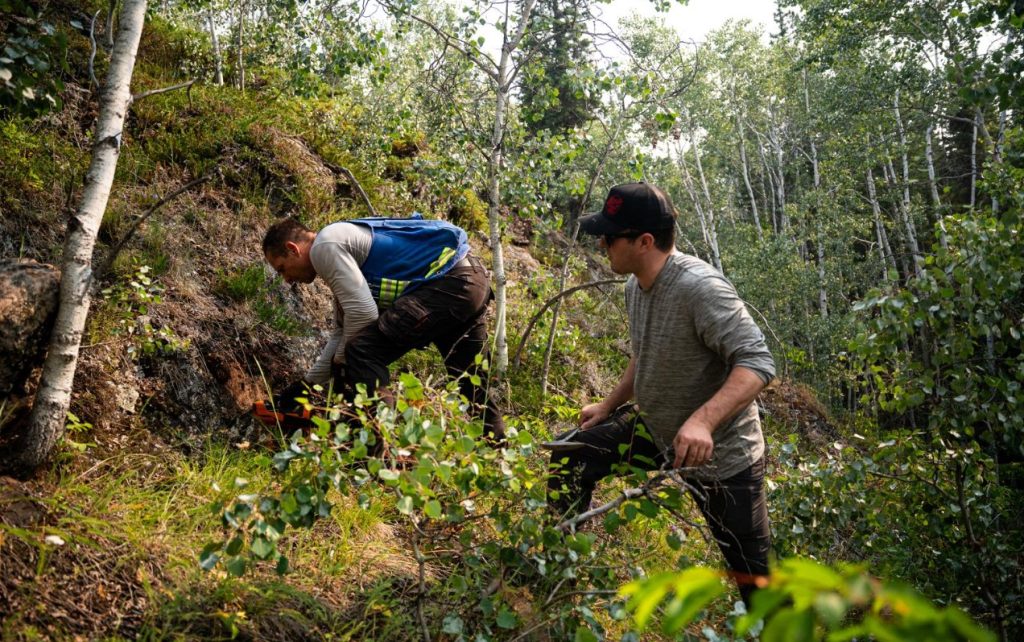Standard Uranium discovers visible mineralization at Sun Dog Project, Uranium City, Saskatchewan

Standard Uranium Ltd. [TSXV-STND; OTCQB-STTDF; FSE-9SU] reported new prospecting results and drill target areas at its Sun Dog Uranium Project near Uranium City, northwestern Saskatchewan.
A drilling campaign is scheduled to commence in the coming week, designed to test high-priority targets with the potential to discover high-grade, unconformity-related basement-hosted uranium mineralization along structural and conductive corridors.
The project is currently under a three-year earn-in option agreement with Aero Energy Ltd. [TSXV-AERO] that was executed on October 20, 2023. The program will be funded by Aero and will be operated by the company.
Highlights: Drilling at Sun Dog Imminent: Multiple prospective drill targets have been prioritized following prospecting of conductive (graphitic) rock trends identified from the recent VTEMTM Plus airborne survey.
Undrilled Target Areas: Targets are designed to test conductive corridors marked by newly discovered radioactive graphitic fault zones outcropping at surface.
Wishbone Target Area: Recent prospecting has outlined new and historical uranium mineralization at surface with radioactivity readings up to 22,300 counts per second (cps) within and immediately adjacent to graphitic pelite that has never been drill tested.
McNie Target Area: More than 4km of untested VTEMTM conductors off-set by major faults which host known uranium showings to the east and to the west towards the past-producing Gulch uranium mine.
Spring-Dome Target Area: New and historical zones of strong radioactivity >65,535 cps at surface associated with visible uranium mineralization have been discovered during the recent prospecting program at the Spring-Dome target area.
Historical High-Grade Uranium Assays: The Wishbone and Spring-Dome Target Areas contain numerous historical high-grade** uranium assays from outcrop samples that rangefrom 0.30% to 17.4% U3O8.
2024 Drill Program: Drilling is expected to commence on July 21st with the program comprising approximately 1,000 to 1,200 metres within five to seven drill holes. The program will be results-driven with modification made based on ongoing results and interpretations.
Sean Hillacre, President, VP Exploration, commented: “Our recent prospecting program at Sun Dog significantly upgraded our target zones for this summer’s drill program. Locating and mapping radioactive graphitic pelitic rocks at surface, which are the ideal host rocks we are targeting, is exceptional. The technical team and I were pleasantly surprised by the quality of the showings we were able to ground truth and expand, sharpening our targeting for drilling to start next week.”
A helicopter-borne geophysical survey, including electromagnetics and magnetics, was completed during late April 2024. The survey was undertaken by Geotech Ltd. usingp on a 100-metre line spacing, obtaining new coverage and refining historical EM surveys on the Project. Ground gravity data acquired during 2022 and historical resistivity data were subject to 3D inversion and modelling.
Sun Dog covers an area of 48,443 acres in nine mining claims, located 15 km from Uranium City on the northern margin of the Athabasca Basin. It hosts the historical Gunnar Uranium Mine, discovered in 1952, which doubled Canada’s uranium production and became the largest uranium producer globally in 1956. The Gunnar Mine produced approximately 18M lbs of U3O8 between 1953 and 19811,2.
Recent exploration efforts by Standard Uranium have focused on the most promising historical target areas along the edge of the Athabasca Basin, namely Skye, Java, and Stewart Island, testing down-dip extensions of structures hosting uranium at surface with the aim of discovering high-grade unconformity mineralization and basement “roots” of the mineralizing systems underlying the Athabasca sandstones.
Prospecting by the Company led to the discovery of a new high-grade uranium showing named the Haven discovery and several zones of visible uranium mineralization at surface that returned uranium assay results of 3.58% U3O8, 1.7% U3O8, and 0.7% U3O8. The expanded surface expression of mineralization on south Johnston Island displayed scintillometer readings >10,000 cps and locally off-scale (>65,535 cps) and the historical mineralized surface occurrences on Stewart Island were confirmed with scintillometer measurements ranging from >500 cps to >65,535 cps. Radioactivity measurements were collected with hand-held RS-121 or RS-125 scintillometers.
Standard Uranium carried out two drill programs on the project during the winters of 2022 and 2023. In total, 2,469 metres of diamond drilling was completed in 14 drill holes. The 2022 and 2023 diamond drill programs were successful in identifying key geological characteristics prospective for significant uranium mineralizing systems on the Project, including widespread hydrothermal alteration zones containing dravitic clays, reactivated graphitic shear zones and quartz-hematite breccias, and uranium mineralization including 0.042 wt.% U308 from 79.0 to 79.5 m and 0.021 wt.% U308 from 79.5 to 80.0 m in drill hole SD-23-013.
Standard Uranium holds interests in over 209,867 acres (84,930 hectares) in the Athabasca Basin.
Standard Uranium successfully completed three joint venture earn in partnerships on their Sun Dog, Canary, and Atlantic projects totaling over $23.8M in work commitments over the next three years from 2024-2027.
Standard Uranium’s Davidson River Project, in the southwest part of the Athabasca Basin, Saskatchewan, comprises 10 mineral claims over 30,737 hectares. Davidson River is highly prospective for basement-hosted uranium deposits due to its location along trend from recent high-grade uranium discoveries. Recent intersections of wide, structurally deformed and strongly altered shear zones provide significant confidence in the exploration model and future success is expected.
Standard Uranium’s eight eastern Athabasca projects comprise 30 mineral claims over 32,838 hectares. The eastern basin projects are highly prospective for unconformity related and/or basement hosted uranium deposits based on historical uranium occurrences, recently identified geophysical anomalies, and location along trend from several high-grade uranium discoveries.
Standard Uranium’s Sun Dog project, in the northwest part of the Athabasca Basin, Saskatchewan, is comprised of nine mineral claims over 19,603 hectares.
